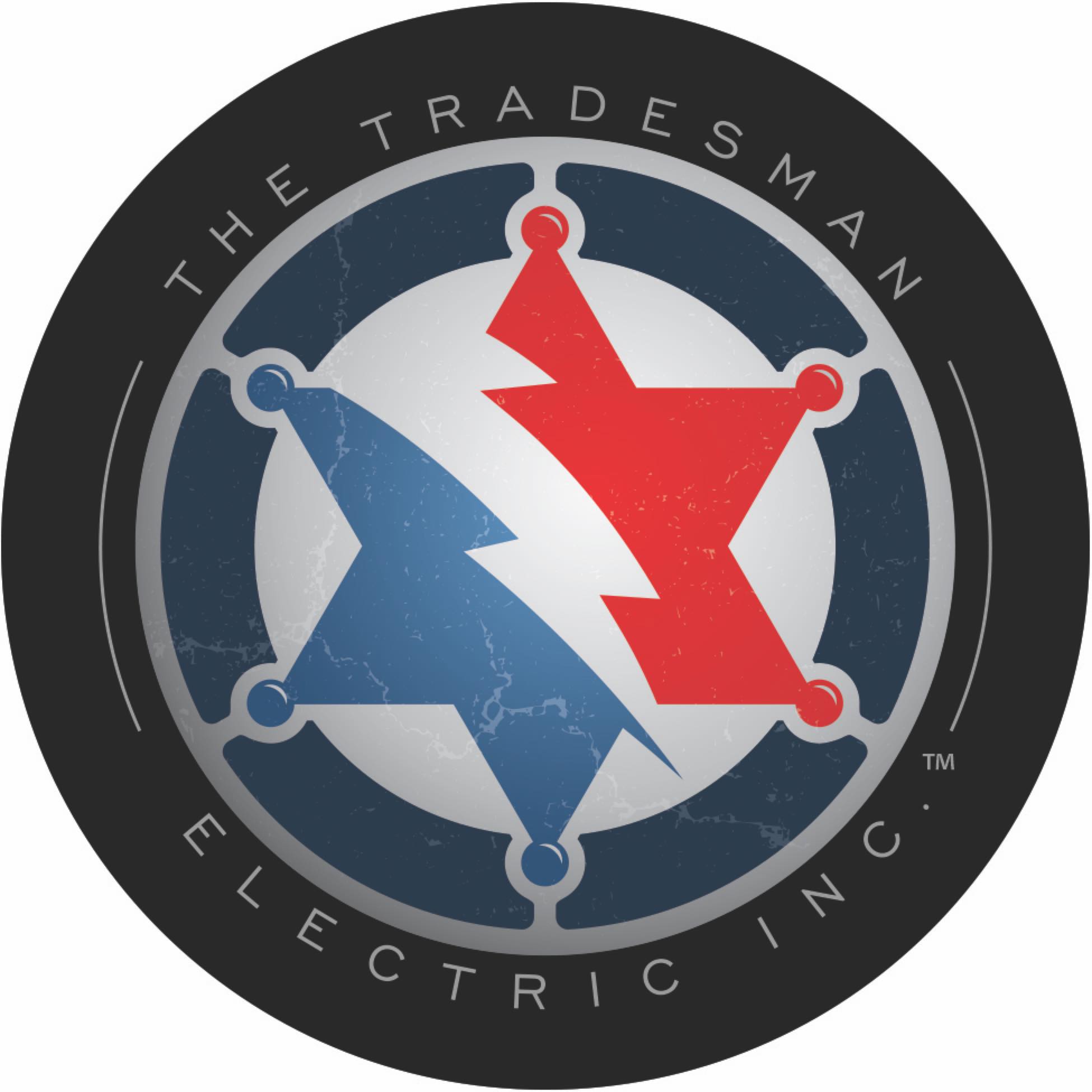Electrical Panel Basics: Your Complete Guide to Home Electrical Safety
Your electrical panel quietly manages every electrical device in your home, yet most homeowners know little about this critical safety component. Understanding electrical panel basics isn’t just about technical knowledge—it’s about protecting your family, your property, and your peace of mind.
Understanding electrical panels is essential for ensuring safe operation, proper installation, and effective maintenance of your home’s electrical system.
According to the National Fire Protection Association, electrical distribution systems account for 11% of home fires in the United States. Many of these incidents could be prevented with proper knowledge of electrical panels and maintenance. Whether you’re a new homeowner trying to understand your home’s electrical system or someone experiencing electrical issues, this comprehensive guide will help you navigate the essential aspects of electrical panels safely and confidently.
What Is an Electrical Panel?
An electrical panel serves as the “brain” of your home’s electrical system, controlling how electrical power flows throughout your property. These metal boxes, also known as electrical panels, contain circuit breakers that manage the distribution of electricity to separate circuits in your home, ensuring each area receives the appropriate amount of electrical current.
The main function of an electrical panel is to distribute power safely to different circuits throughout your home while providing crucial protection against electrical hazards. When electrical devices draw too much power or when short circuits occur, the electrical panel automatically shuts off power to prevent electrical fires and protect your electrical devices from damage.
You might hear people refer to electrical panels by several different names, including breaker box, electric service panel, or circuit breaker panel. The central panel is often called simply the service panel. Regardless of what you call it, this critical component manages every electrical circuit in your home, from basic lighting to high-power appliances like your HVAC systems.
Modern electrical panels contain sophisticated safety features that older fuse boxes couldn’t provide. Unlike the screw in fuses found in older homes, today’s circuit breakers can be easily reset after they trip, making them both safer and more convenient for homeowners.
Where to Find Your Electrical Panel
Most electrical panels, also known as electric service panels, are located in areas that provide easy access while staying out of daily living spaces. In homes, you’ll typically find your main service panel in basements, garages, utility rooms, or laundry areas. These locations keep the panel accessible for maintenance while protecting it from moisture and daily household activities.
Apartment dwellers often find their electric service panel near the entrance, in bedroom closets, or along hallway areas. Some apartments have the main panel in a utility closet shared with other units, while individual apartments may have smaller sub-panels controlling their specific electrical circuits.
Older homes sometimes feature outdoor installations, where the main breaker panel is mounted on the exterior wall near where buried power lines or the service drop connect to the building. While this placement was common decades ago, most modern installations place panels indoors for better protection from the weather and easier access.
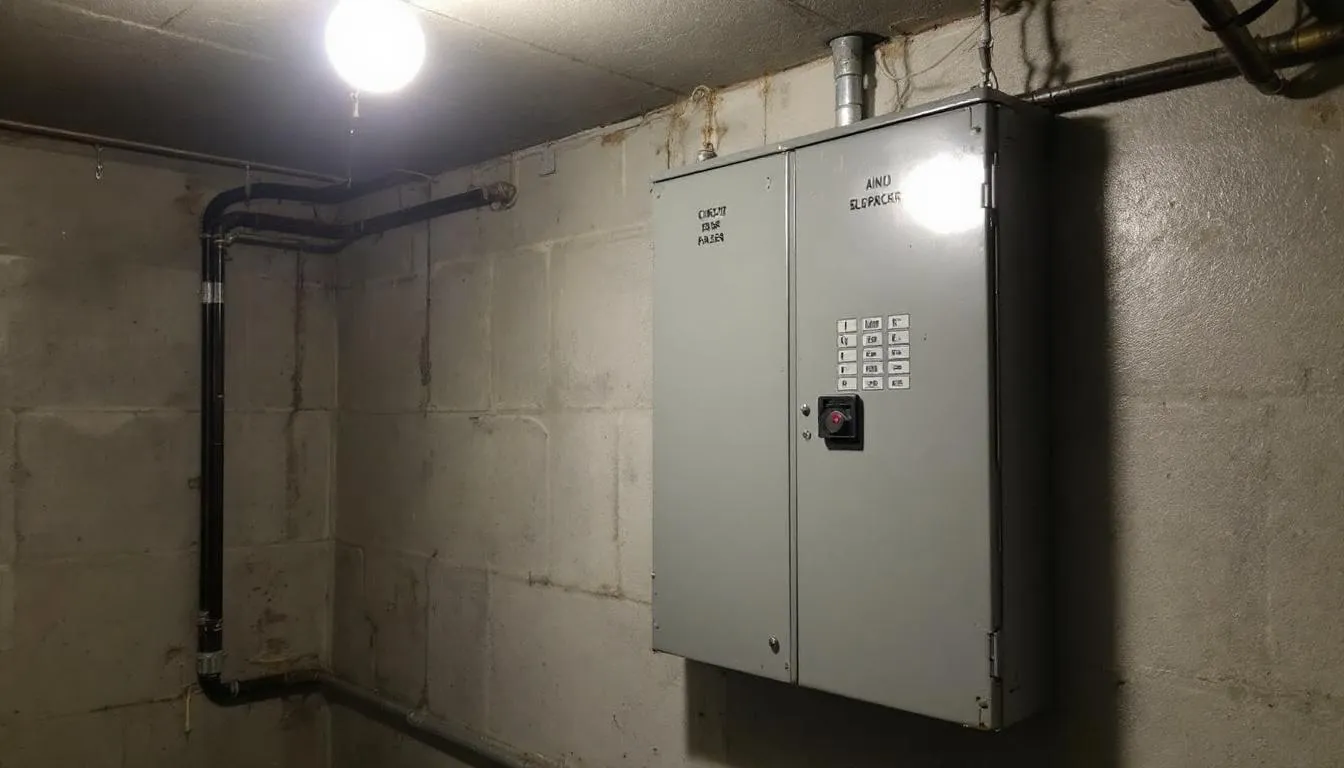
You can identify your electrical panel by looking for a gray metal box—these metal boxes are the standard enclosures for electric service panels—with a hinged door covering multiple breaker switches arranged in rows. The door should be clearly marked and may include basic safety warnings or information from the utility company.
Many larger homes have multiple panels: a central panel that receives electrical power from the utility company, plus separate circuits managed by subpanels for additions, workshops, or detached buildings. Understanding this configuration helps you locate the right panel when you need to shut off power to specific areas. Knowing the location of your panel is crucial during an electrical emergency, as quick access can help you respond to power outages or safety hazards.
How Electrical Panels Work
Understanding how electrical panels work begins with following the path electricity takes from the utility company to your electrical devices. Electrical power enters your home through thick wires that connect to your main circuit breaker, which acts as the master switch controlling power to your entire house.
The main breaker serves as the first line of protection for your home’s electrical system. When you flip this breaker switch to the off position, it disconnects electricity to the entire building, making it essential for safety during electrical emergencies or when professional electricians need to perform electrical panel work.
Individual circuit breakers control specific areas, rooms, or appliances throughout your home. Each single circuit breaker protects its assigned electrical circuit by monitoring the electrical current flowing through it. When a circuit becomes overloaded or experiences a short circuit, the breaker automatically trips, cutting power to prevent electrical fires or damage to electrical devices.
Amperage ratings determine how much electrical load each circuit can safely handle. Most residential electrical panels feature amperage ratings from 100 to 400 amps, depending on the size of the home and its electrical needs. A typical 200-amp service panel can handle the electrical demands of most modern homes, including major appliances and HVAC systems.
Your electrical panel also manages different voltage levels throughout your home. Standard outlets operate at 120 volts, making them ideal for everyday electrical devices like lamps, computers, and small appliances. Larger appliances such as electric dryers, water heaters, and air conditioning units require 240-volt circuits, which use toggle switch circuit breakers that take up two spaces in the panel.
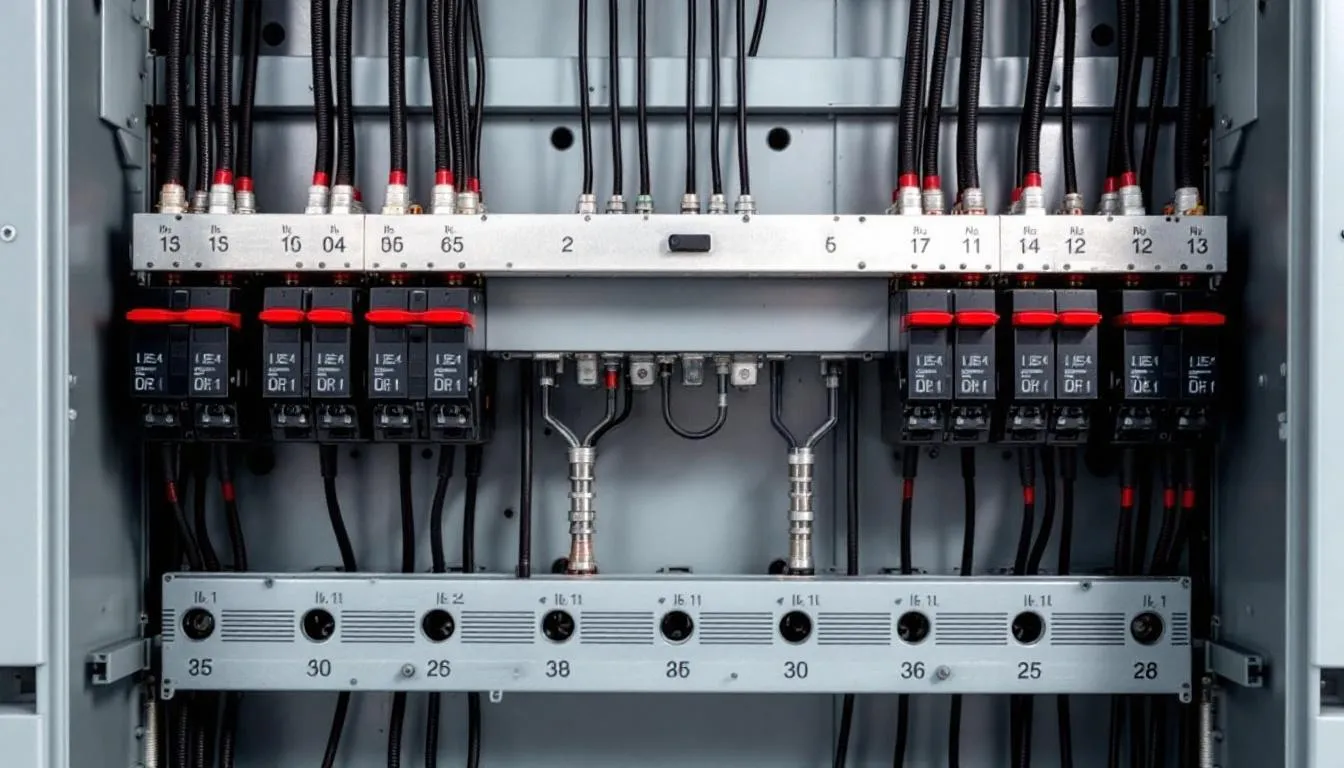
The electrical current flows through bus bars—metal strips that distribute power from the main breaker to individual circuit breakers. These critical components ensure reliable electrical distribution while maintaining the safety features that protect your home from electrical hazards.
Types of Circuit Breaker Panels
Modern electrical panels come in several configurations, each designed for specific applications and safety requirements. Understanding these differences helps you identify what type of system protects your home and whether upgrades might be necessary.
Main breaker panels represent the most common type found in modern homes. These panels include a built-in main circuit breaker that controls power to the entire electrical system. This design provides convenient access to shut off all electrical power during emergencies while offering individual control over separate circuits throughout the home. For a detailed comparison, see main breaker panels.
Subpanels serve as additional distribution points when the main panel reaches capacity or when specific areas need dedicated electrical service. You might find a subpanel in a detached garage, home addition, or workshop where extra circuits are required beyond what the main service panel can accommodate. Subpanels are often installed when more circuits are needed than the central panel can support.
Older homes may still have fuse boxes, also known as fuse panels, instead of modern circuit breaker panels. These systems use screw in fuses that must be physically replaced when they “blow” due to overloads. While fuse panels can function safely, they lack the convenience and advanced protection features of modern electrical panels.
Federal Pacific and Zinsco panels pose serious safety risks and should be replaced immediately. These dangerous panel brands have documented histories of failing to trip during electrical faults, creating significant fire hazards and safety concerns. If your home has either a Federal Pacific Electric (FPE) or Zinsco panel, contact Tradesman Electric immediately for replacement options.
Modern electrical panels include advanced safety features that significantly reduce risks of electrical fires and electrical shock. Ground Fault Circuit Interrupter (GFCI) and Arc Fault Circuit Interrupter (AFCI) breakers provide protection that older fuse boxes simply cannot match, reducing injury and fire risks by up to 70% according to Consumer Product Safety Commission estimates.
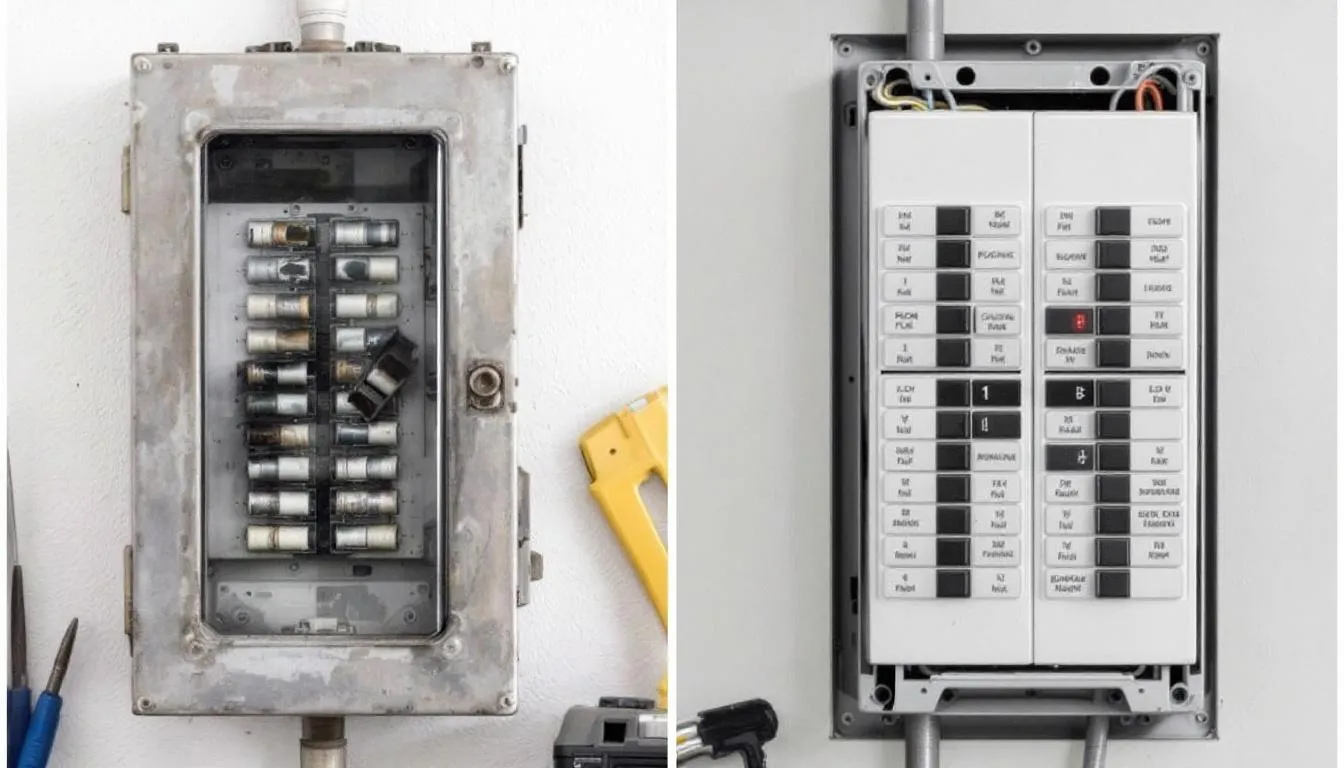
The electrical service panel in your home should match your electrical needs and comply with current building codes. If you’re unsure about your panel type or its safety, professional electricians can evaluate your system and recommend appropriate upgrades.
Electrical Service Panel Components
The electrical service panel, often called a breaker box or electrical panel, serves as the gentle guardian of your family’s electrical needs throughout your home. Housed within a reliable metal enclosure, this comprehensive system brings together several essential components that work harmoniously to ensure your family enjoys safe, dependable electrical power in every room of your house.
At the heart of this family-friendly system are the circuit breakers—your home’s dedicated protectors. These thoughtful safety devices are designed to gently disconnect power when they detect potential concerns, creating a warm shield of protection around your family’s daily activities and cherished appliances. Each circuit breaker is carefully assigned to specific areas of your home, ensuring that any minor electrical concern in one room doesn’t disrupt the comfortable routines your family depends on throughout the rest of your house.
The main circuit breaker stands as your home’s master protector, offering comprehensive control over your family’s electrical comfort and safety. This reliable component manages the flow of power from your utility company into your home’s welcoming spaces. During any family emergency, simply switching the main circuit breaker to the off position provides immediate, complete protection for your entire household—giving both homeowners and professional electricians the peace of mind that comes from having dependable safety measures in place.
Bus bars, constructed as robust metal strips within the panel, form the carrying backbone of your family’s electrical distribution system. These sturdy components carry electrical energy from the main circuit breaker to each circuit breaker, ensuring every area of your home receives the gentle, consistent power your family needs for comfortable daily living. The high-quality construction of these bus bars reflects a commitment to safely and efficiently handling your family’s electrical needs for years to come.
All of these family-focused components rest securely within the protective metal enclosure of your electrical service panel, shielding them from dust, moisture, and any accidental contact that might concern family members. Understanding these essential elements not only helps you appreciate the comprehensive care built into your home’s electrical system but also empowers you to recognize when your family might benefit from professional attention—ensuring you can connect with a trusted, licensed electrician before minor concerns become anything that might disrupt your family’s comfort and safety.
Fuse Boxes and Breaker Boxes
When it comes to protecting your family’s safety and peace of mind, the type of electrical panel in your home makes all the difference. Families throughout our community often discover that older homes feature fuse boxes. At the same time, modern residences benefit from advanced breaker boxes—each offering distinct advantages that directly impact your family’s comfort and security.
Fuse boxes use traditional screw-in fuses to safeguard individual circuits throughout your home. When a circuit experiences an overload, the fuse “blows,” effectively breaking the electrical connection and preventing potential hazards. While this protective feature prevents dangerous electrical fires, it also means you’ll need to replace each blown fuse with a new one whenever an overload occurs. This process can become inconvenient for busy families and, if the wrong type of fuse is installed, may actually compromise your home’s safety.
Breaker boxes, on the other hand, offer the convenience and reliability that modern families deserve. These advanced systems use circuit breakers that can be easily reset after they trip, providing immediate peace of mind. When a circuit becomes overloaded or experiences a short circuit, the circuit breaker automatically shuts off power to protect that specific area of your home. Restoring power is as simple as flipping the breaker switch back to the on position—no need to search for replacement fuses or worry about compatibility issues. Breaker boxes are also expertly designed to handle higher electrical loads and offer tremendous flexibility for expanding your home’s electrical system as your family’s needs grow and evolve.
Modern electrical panels with circuit breakers represent the gold standard for both safety and everyday convenience. They provide superior protection against electrical fires while seamlessly accommodating today’s essential electrical devices and appliances that keep your family comfortable and connected. If your home still relies on an outdated fuse box, now is the perfect time to consider an upgrade that will benefit your family for years to come. Licensed electrical professionals in your community can thoroughly assess your current electrical panel, recommend the ideal solution tailored specifically to your home’s needs, and perform the expert installation work necessary to ensure your electrical system is safe, reliable, and entirely up to code.
Upgrading from a fuse box to a modern breaker box not only enhances your family’s safety but also transforms how you manage your home’s electrical system. The convenience, reliability, and peace of mind this investment offers truly make a difference in your daily life. If you’re uncertain about the type of panel currently protecting your home or suspect you may benefit from an upgrade, don’t wait to consult with a trusted professional electrician who can safeguard both your property and your family’s well-being.
Common Electrical Panel Problems
Recognizing electrical panel problems early can prevent dangerous situations and costly damage to your home’s electrical system. Several warning signs indicate when your electrical panel needs professional attention from licensed electricians.
Frequent breaker trips often signal underlying electrical issues that require investigation. While circuit breakers are designed to trip when circuits become overloaded, repeated tripping of the same breaker suggests problems with electrical devices, loose connections, or insufficient electrical capacity for your needs. Outdated panels can also lead to unexpected outages and circuit trips, reducing system reliability and safety.
Flickering lights throughout your home can indicate connection issues within your electrical panel or overloading circuits beyond their safe capacity. This problem becomes especially concerning when lights dim or flicker when large appliances start up, suggesting your electrical panel may struggle to handle your home’s electrical load. Major appliances should have their own breaker to ensure safety and proper load management.
Burning smells near your electrical panel are a serious safety concern that requires immediate attention from professional electricians. Any unusual odors, especially those resembling burning plastic or metal, could indicate dangerous electrical problems that pose fire hazards.
Corrosion and rust on panel surfaces or around individual breakers signal moisture problems that compromise electrical safety. Water and electricity create hazardous combinations, and any signs of moisture intrusion need professional evaluation and correction.
Hot panel covers indicate dangerous electrical problems developing within your electrical system. If the metal box feels warm or hot to the touch, this suggests overloaded circuits, bad circuit breaker connections, or other serious electrical issues requiring immediate professional intervention.
Insufficient capacity problems arise when older electrical panels can’t handle modern electrical demands. Homes with 60-amp or older 100-amp services often struggle with today’s electrical devices, HVAC systems, and appliances, leading to frequent tripping and safety concerns.
Warning Signs You Need Professional Help
Several specific warning signs indicate when you should immediately contact licensed electricians rather than attempting to diagnose or fix electrical problems yourself.
Breakers that won’t reset or trip immediately after being reset suggest serious electrical faults that require professional diagnosis. A bad circuit breaker or underlying electrical issues could be creating dangerous conditions in your electrical system.
Scorch marks around breakers or panel surfaces indicate previous electrical arcing or overheating that could have caused electrical fires. These visible signs of electrical problems require a thorough professional evaluation to prevent future incidents.
Crackling or buzzing sounds from your electrical panel signal loose connections or electrical arcing that creates fire hazards. These sounds often worsen over time and represent serious electrical problems that need immediate professional attention.
Mild electrical shock when touching appliances or switches suggests grounding problems in your electrical system that compromise safety. This dangerous condition requires immediate evaluation by professional electricians to prevent more serious electrical emergencies.
Insurance companies increasingly require electrical panel upgrades for older homes or those with known problematic panel brands. If your insurance provider has flagged your electrical panel, addressing these concerns promptly protects both your coverage and your safety.
When to Upgrade Your Electrical Panel
Several factors indicate when your electrical panel needs to be upgraded to maintain safety and meet your home’s electrical needs. Understanding these triggers helps you plan for necessary improvements before problems become emergencies.
Home age represents a primary factor in determining upgrade needs. Electrical panels that are more than 20-30 years old often lack modern safety features and may struggle to meet contemporary electrical demands. Older panels typically need to be replaced to meet current building codes and safety standards.
Insufficient amperage creates ongoing problems for homes with growing electrical needs. Properties with 60-amp services or outdated 100-amp panels often require upgrades to 200-amp or higher capacity to safely handle modern appliances, HVAC systems, and electrical devices without overloading circuits.
Home additions frequently necessitate electrical panel upgrades to accommodate additional circuits for new rooms, appliances, or heating and cooling systems. When your current panel lacks space for more circuit breakers, upgrading to a larger electrical service panel provides the capacity needed for safe expansion.
Safety upgrades become mandatory when homes have dangerous Federal Pacific or Zinsco panels that fail to provide adequate protection. For safety reasons, upgrades are often required to prevent hazards such as electrical shock and fire. These problematic brands require immediate replacement with modern electrical panels that meet current safety standards and building codes.

Insurance requirements often drive panel upgrade decisions when companies refuse coverage for homes with outdated or dangerous electrical systems. Upgrading your electrical panel not only improves safety but often reduces insurance premiums and ensures continued coverage.
Code compliance issues arise when local authorities require electrical systems to meet current standards. Whether you’re selling your home, completing renovations, or responding to inspection requirements, panel upgrades ensure your electrical system meets all applicable building codes.
If you’re considering any electrical panel upgrades, contact Tradesman Electric for professional evaluation and detailed upgrade options tailored to your specific needs.
Electrical Panel Safety Guidelines
Here are essential safety tips for working with or around electrical panels.
Electrical panel safety requires following strict guidelines that protect both you and your property from dangerous electrical hazards. These essential safety practices should guide every interaction with your electrical system.
Never attempt electrical panel work yourself—always call licensed electricians for any work involving your main panel, circuit breakers, or electrical connections. Even seemingly simple tasks like installing new circuit breakers require professional expertise to ensure safety and code compliance.
Keep panel areas clear and accessible for emergency access by maintaining at least three feet of clearance around your electrical service panel. This space provides safe access during electrical emergencies and enables professional electricians to work safely during maintenance or upgrades.
One of the most important safety tips is to avoid moisture near electrical panels by installing dehumidifiers in damp basements or by promptly addressing water intrusion problems. Water and electrical systems create hazardous combinations that can cause electrical shock, electrical fires, and equipment damage.
Another key safety tip is to label circuits clearly for both safety and convenience, ensuring each circuit breaker is clearly identified with the electrical devices or areas it controls. Proper labeling enables quick responses during electrical emergencies and helps professional electricians work more efficiently.
Regular professional inspections every 3-5 years help identify potential problems before they become dangerous electrical emergencies. These evaluations can detect loose connections, aging components, or capacity issues that might compromise electrical safety.
Emergency procedures should include knowing how to locate and operate your main breaker to shut off electrical power during emergencies. However, only attempt this during genuine emergencies, and always contact professional electricians for electrical problems requiring investigation or repair.
Understanding Circuit Breakers
Circuit breakers serve as the primary protection mechanism in modern electrical panels, automatically shutting off electrical current when dangerous conditions develop. Understanding how these critical components work helps you appreciate the sophisticated protection they provide for your home’s electrical system.
Modern circuit breakers protect your home from electrical fires by constantly monitoring the electrical current flowing through each circuit. When current exceeds safe levels due to overloading or short circuits, the breaker automatically trips to prevent dangerous overheating that could cause an electrical fire.
Different amperage ratings correspond to specific electrical needs throughout your home. Common ratings include 15-amp breakers for lighting and standard outlets, 20-amp breakers for kitchen and bathroom circuits, and higher ratings like 30, 40, or 50 amps for large appliances and electrical devices requiring more electrical power.
Single-pole breakers control 120-volt circuits typical for most electrical devices, while double-pole breakers manage 240-volt circuits needed for electric dryers, water heaters, and HVAC systems. Understanding these differences helps you identify which breaker switch controls specific electrical devices in your home.
GFCI and AFCI breakers provide advanced protection that significantly enhances electrical safety in modern homes. GFCI breakers prevent electrical shock by detecting ground faults and shutting off power within milliseconds, while AFCI breakers identify dangerous arc faults that could cause electrical fires.
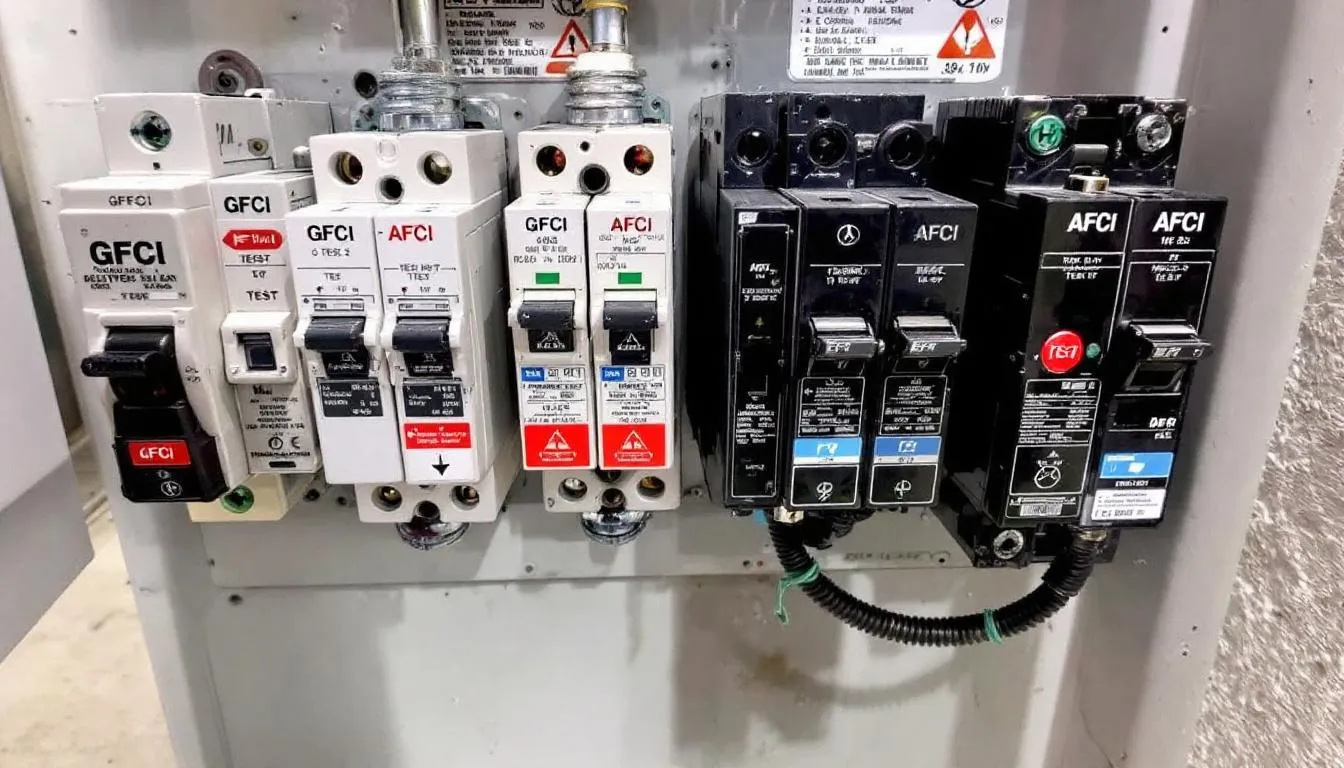
Proper breaker resetting procedures involve first identifying why the breaker tripped, addressing any obvious problems, and then firmly pushing the toggle switch to the off position before switching it back to on. However, if a breaker trips repeatedly, contact professional electricians rather than continuing to reset it.
When breakers trip frequently or won’t reset properly, this indicates serious electrical problems requiring professional diagnosis. Never attempt to bypass tripped breakers or ignore repeated tripping, as these safety mechanisms protect your home from dangerous electrical conditions.
Mapping Your Home’s Electrical Circuits
Proper circuit labeling represents a critical safety measure that every homeowner should prioritize for their electrical system. Accurate identification of what each breaker controls enables quick responses during electrical emergencies and helps professional electricians work more efficiently.
The importance of proper circuit labeling extends beyond convenience to genuine safety concerns. During electrical emergencies, you need to quickly identify which circuit breaker controls specific areas or electrical devices to shut off power safely. Clear labeling eliminates dangerous guesswork during critical moments.
Creating an accurate circuit map involves a systematic process of testing each circuit breaker to determine what electrical devices, outlets, or areas it controls. This process requires turning off individual breakers while checking throughout your home to identify which electrical devices lose power.
Start by gathering supplies, including sticky labels, a pen, and a helper to assist with checking different areas of your home. Begin with one circuit breaker, switch it to the off position, then systematically check every electrical device, outlet, and light switch throughout your home to identify which one lost power.
Best practices for labeling include using clear, descriptive terms rather than nicknames or abbreviations that might confuse others. Instead of labeling a breaker “John’s room,” use “Master bedroom outlets and ceiling fan” to provide specific, useful information for anyone accessing your electrical panel.
Document your findings by creating a comprehensive circuit map that lists each breaker number alongside detailed descriptions of what it controls. This reference document proves invaluable during electrical emergencies, renovations, or when professional electricians need to work on your electrical system.
For complex electrical systems or homes with multiple panels, consider contacting Tradesman Electric for professional circuit mapping services. Our licensed electricians can efficiently identify all circuits while ensuring your electrical system meets current safety standards and building codes.
Professional Electrical Panel Services
Electrical panel work requires the expertise of licensed electricians who understand complex electrical systems, safety protocols, and building codes. Attempting electrical panel work without proper training and licensing creates serious safety risks and potential code violations.
Permit requirements for electrical panel upgrades and installations vary by location, but typically require professional electrical work to ensure compliance with local building codes. Licensed electricians handle all the necessary permits and inspections, ensuring your electrical panel upgrade complies with all legal requirements.
At Tradesman Electric, our expertise covers all electrical panel types and brands, including safe replacement of dangerous Federal Pacific and Zinsco panels that pose serious fire hazards. Our licensed electricians stay up to date with evolving electrical codes and safety standards to provide the most reliable electrical panel services.
Code compliance assurance comes standard with every Tradesman Electric installation, backed by comprehensive warranty protection that gives you confidence in your electrical system’s safety and reliability. We ensure every electrical panel upgrade meets or exceeds current building codes and safety requirements.
Emergency electrical panel services are available 24/7 for situations requiring immediate professional attention. Whether you’re experiencing electrical emergencies, repeated breaker trips, or signs of dangerous electrical problems, our skilled electricians respond quickly to protect your property and safety.
Our comprehensive services include electrical panel evaluations, capacity upgrades, safety improvements, and complete electrical panel replacements. We work with homeowners and commercial buildings to ensure electrical systems meet current demands while maintaining the highest safety standards.
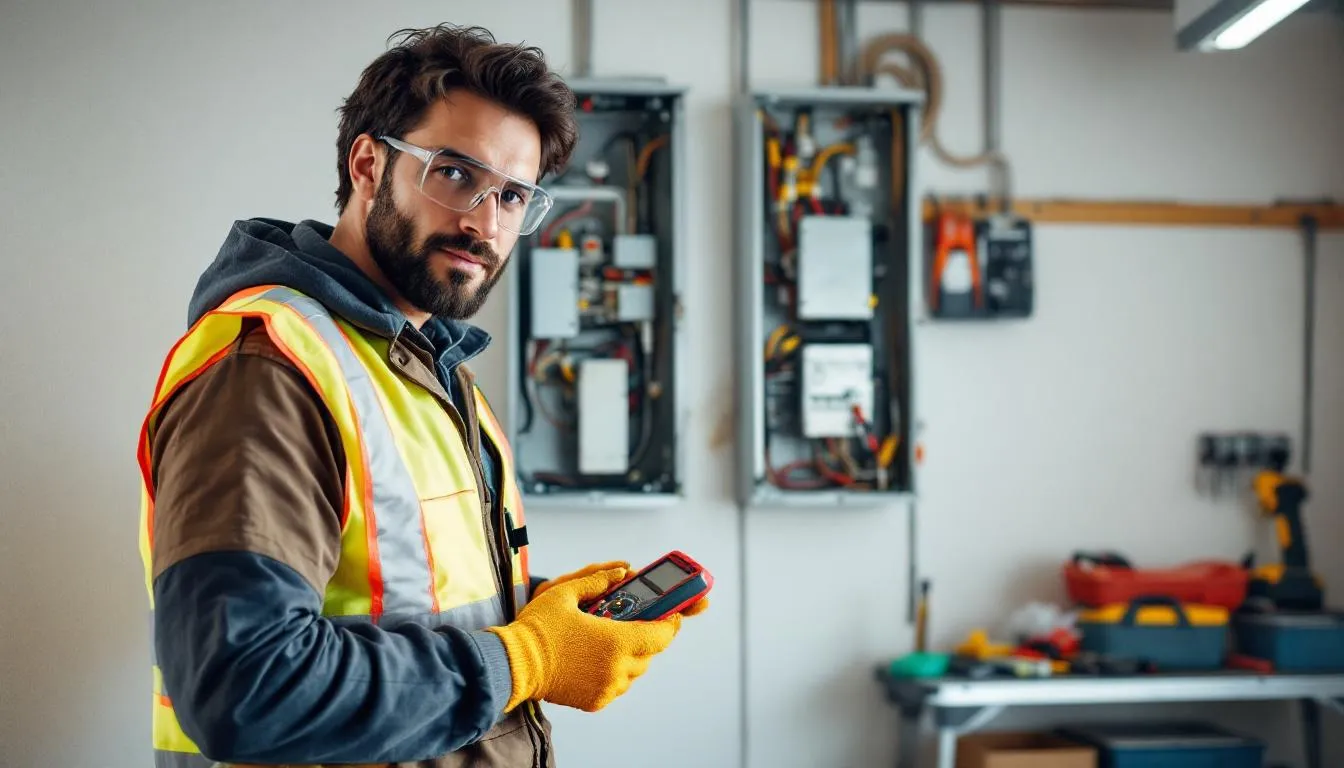
When electrical problems arise or you’re considering electrical panel upgrades, don’t risk your safety with unqualified work. Contact Tradesman Electric for detailed cost estimates and professional consultations that address your specific electrical needs.
Understanding the basics of electrical panels empowers you to make informed decisions about your home’s electrical system and recognize when professional expertise is necessary. Your electrical panel represents one of the most critical safety components in your home, deserving the attention and respect that protects your family and property.
From recognizing warning signs of electrical problems to understanding when electrical panel upgrades become necessary, this knowledge helps you maintain a safe electrical system. Remember that while understanding your electrical panel is valuable, actual electrical panel work should always be performed by licensed electricians who ensure safety and code compliance.
Whether you need electrical panel evaluation, emergency electrical services, or comprehensive electrical panel upgrades, Tradesman Electric provides the professional expertise and reliable service you deserve. Don’t risk your family’s safety with electrical panel issues—contact Tradesman Electric today for expert evaluation and service that prioritizes your safety above all else.
